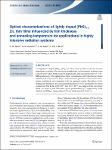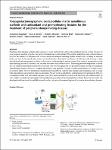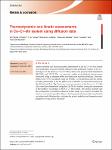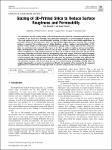Search
Author
- Manyk, T. (3)
- Murawski, K. (3)
- Baumgartner, Jörg (2)
- Guizani, Chamseddine (2)
- next >
Subject
Date issued
- 2023 (187)
Has File(s)
- true (187)
Search Results
The paper presents original data of 3D EBSD orientation maps collected for 13 Yttria-Stabilized Zirconia (YSG) samples, sintered at different temperatures for different times. The largest map contains 18,833 grains and 64,506 grain boundaries. These data allowed for the analysis of grain boundary networks, based on all 5 macroscopic parameters and some topological studies of microstructures. Grain boundaries having the (001) and (111) boundary planes are favored and disfavored respectfully in all YSZ samples. The anisotropy appears to be stronger if grains are larger. However, large grains themselves do not imply strong anisotropy. Symmetric boundaries are slightly more frequent in YSZ compared to random boundaries, but despite some premises, the evidence for over-representation of ... |
The lightly Zn-doped (PbS)1−x (Zn)x thin films were synthesized by the thermal deposition technique. The structure, morphology, and elemental analyses were carried out by XRD, SEM, and EDS, respectively, and characterised by UV–VIS–NIR spectroscopy. The optical absorption, transmission, and reflection have been studied and analysed. The linear and non-linear parameters have been determined, explained, and compared with the reported results. The effects of Zn-doping, film thickness, and annealing temperature on NLO-parameters have been considered. The better 2.78 × 10–10 and 2.93 × 10–10 esu values of the non-linear refractive index n2 and 3rd-order optical polarizability χ(3), respectively, were attained by (PbS)0.97 (Zn)0.03 film of 150 nm thick annealed at 200 °C. |
The burgeoning field of digital humanities has provided important modern technological means for text mining in literary works. Chinese classical poetry, as a treasure in the world’s artistic treasury, holds significant value in recognizing the heritage of world culture. In this study, taking the 1589 Tang poems from the Tang Poetry Road in Eastern Zhejiang as an example, we constructed a research framework that explores the aesthetics of classical Chinese poetry landscapes and spatial imagery at the urban agglomeration scale by utilizing geographic and analytical tools such as Python programming, Gephi co-occurrence semantic networks, and GIS kernel density analysis. The framework exhibits three key innovations: (1) a text processing approach that treats individual characters as se... |
The application of functional materials and devices (FM&Ds) underpins numerous products and services, facilitating improved quality of life, but also constitutes a huge environmental burden on the natural ecosystem, prompting the need to quantify their value-chain impact using the bottom-up life cycle assessment (LCA) framework. As the volume of FM&Ds manufactured increases, the LCA calculation speed is constrained due to the time-consuming nature of data collection and processing. Moreover, the bottom-up LCA framework is limited in scope, being typically static or retrospective, and laced with data gap challenges, resulting in the use of proxy values, thus limiting the relevance, accuracy, and quality of results. |
Peripheral demyelinating diseases entail damage to axons and Schwann cells in the peripheral nervous system. Because of poor prognosis and lack of a cure, this group of diseases has a global impact. The primary underlying cause of these diseases involves the inability of Schwann cells to remyelinate the damaged insulating myelin around axons, resulting in neuronal death over time. In the past decade, extensive research has been directed in the direction of Schwann cells focusing on their physiological and neuroprotective effects on the neurons in the peripheral nervous system. One cause of dysregulation in the remyelinating function of Schwann cells has been associated with oxidative stress. Tissue-engineered biodegradable scaffolds that can stimulate remyelination response in Schwa... |
Atomic mobility and thermodynamic assessments of the fcc Co–Cr–Mn system were performed using the ternary diffusion data. Diffusion couples in the Co–rich region of the ternary fcc Co–Cr–Mn system were prepared and annealed at 900, 1050, and 1150 °C. The concentration profiles across the joint interface were measured using an electron probe microstructure analysis technique. The interdiffusivities were evaluated using the Whittle–Green method, and the atomic mobility parameters of the fcc phase were evaluated via numerical analysis of the diffusional flux. The thermodynamic parameters of the binary fcc Cr–Mn alloy were also determined using the CALPHAD method during the assessment of the mobility parameters in the Co–Cr–Mn system. The atomic mobility and thermodynamic descriptions o... |
The advantages that 3D printing brings to the development and production of customized structures make it suitable for use in the space industry, since spacecraft components are rarely produced in large series. This work explores the use of stereolithography printing of a silica resin for microfluidic applications, in particular small-scale microthrusters, where an impermeable high-temperature material with a smooth surface is required. The printing accuracy, firing shrinkage, surface roughness and permeability of 3D-printed ceramic samples were investigated. Furthermore, glazing of the ceramic material with a stoneware glaze was performed and evaluated with respect to its effect on surface roughness and gas permeability. Open microchannels with diameter down to 250 µm were obtained... |
Tool steels are well known to have superior strength and are claimed to have superior wear resistance than conventional steels in several scenarios. However, their behavior under slurry erosion conditions have been seldom studied. To this end, a set of tool steels, primarily from the CPM yV (y = 1, 3, 9, 10, 15) alloy family, was selected to understand the effect of hardness and vanadium carbide content on the slurry jet erosion (SJE) performance at different impingement angles. It was observed that the SJE resistance increases with the increase in the vanadium carbide volume fraction, but is independent of alloy hardness. |
Nowadays, most SERS platforms are based on plasmonic metals like silver and gold. The current scientific achievement is to construct SERS non-metallic platform with SERS activity not worse than in case of standard metallic platforms. The prominent combination of opto-electronic properties of TiN (titanium nitride) makes it a promising alternative plasmonic material for noble metals. So far, the TiN nanostructures are widely tested in catalysis, especially in photocatalysis. Despite the TiN potential in SERS sensing applications, there are still several fundamental issues preventing its wide practical application. In this work, the surface morphology of TiN layers was tuned from planar 2D to a high aspect ratio 1D nanorod-like structures by industrially scalable normal and glancing a... |
In recent years, the chemical industry is not only striving to produce the best possible products for various applications, but the new products should ideally be based on renewable resources. The ideal case of "cradle to cradle" is generally not achievable in the coatings industry, as maximizing product life and preventing product degradation in the environment is usually one of the main goals of the coatings industry. Therefore, if the coatings industry wants to act sustainably, its efforts should be focused on renewable raw materials. This paper presents a process that makes the renewable raw material phytic acid easily accessible for conventional epoxy and polyol resin coating systems through hydrophobization- and oligomerization. |










